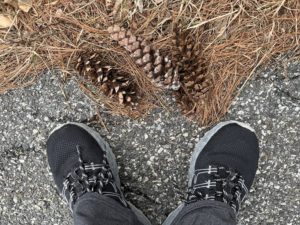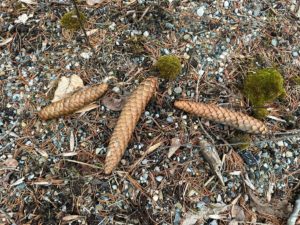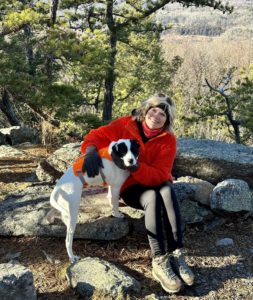Hello fellow readers, We ventured to Blue Mountain Lake, part of the Delaware Water Gap Recreational Area, on Sunday, having not visited since last May when I shared the Flora & Reflections. In winter, evergreens take center stage, and it was fun to see all the young white pines and hemlocks below their momma trees, along with a plethora of pinecones and cones below them. There’s a secret life of pinecones and cones, the fascinating fruits of conifers. Their encasement of woody cones is an ingenious design for protecting and pollinating seeds.

Spent White Pine Pinecones
It’s fascinating how pinecones are pollinated.
Pinecones on pine trees are the vessel by which the seeds are sheltered. Other conifers, such as hemlock, have similar fruit called cones. The tiny seeds are inside the female cones, with two seeds in each scale that spiral around the cone.
Male pinecones are smaller, short-lived, and soft. They often go unnoticed and are typically on the lower branches in spring. It’s a clever system Mother Nature created. That way, the pollen from the male cones won’t fall and pollinate the female cones on the same tree. Instead, the wind will carry the pollen to an adjacent tree.
Pinecones are fruit, though few eat them.
It’s miraculous how a tree knows when to open its male and female pinecones at different times so they can pollinate neighboring trees and not themselves assuring genetic integrity. A pollinated pine seed typically takes two or three years to grow, fall to the ground, or fly in the wind. And pinecones can stay on a tree for ten or more years, depending on the species, before dropping to the ground. When they do, the fertilized seeds are mostly gone.
Another ingenious design of the encasement of woody cones is they’re not palatable to most creatures, but a few, such as squirrels, woodpeckers, and crossbill birds, feed on them. Pinecones date back to the dinosaur age, a favorite of Parasaurolophus dinosaur.
Unlike many plants that rely on pollinators, such as bees, butterflies, and ants, to pollinate seeds, conifers primarily depend upon the wind, although water and fire have a role in it. Pinecones can float merrily downstream, and the tiny seeds inside with wings fly in the wind for as far as a mile.

Norway Spruce Spent Pinecones
Sometimes fire has a role in pollinating cones.
Jack pine (Pinus banksiana) is related to the Scrub Pines (Pinus virginiana) that grace the viewpoint coined Indian Rocks at Blue Mountain Lake. They live in the north-central and northeastern United States and have serotinous cones. The cones have a thick resin that protects the seeds for years while on the tree and requires the heat of a fire to melt the resin and disperse the seeds—a fascinating assurance of survival.
Typically, dry conditions in the late summer and fall trigger cones to ripen. They become entirely brown and open to disperse their seeds. When they fall to the ground, they are “spent” cones – those that have done their job, although there could be a few viable seeds within them.
We enjoy the pinecone seeds in cookies and pesto sauce. Pignoli nuts are expensive due to how long they take to mature and the effort to gather them. Depending on the tree species, seeds can take one to several years to ripen.
How pinecones and cones gererminate:
Folks think if you plant a pinecone, you’ll get a tree which isn’t the case. Conifer seeds are designed to germinate on the surface in no more than a quarter inch of soil or decaying plant debris. By digging them into the earth, you’re prohibiting the opportunity to sprout a baby tree.
We cut down two hemlocks, much to my sadness, but a large branch had fallen between the umbrella pine in the house during a nor’easter one of the trifecta a few years back. The fallen trees opened an opportunity for baby hemlocks to germinate. And now I have a fistful of bouncing baby hemlocks to transplant once they grow to about a foot. I’ll likely keep one or two in the garden to replace their mother trees. Shhhh, don’t tell Curt.
Garden Dilemmas? AskMaryStone@gmail.com and your favorite Podcast App.
There’s much more to the story in Ep 92 of the Garden Dilemmas Podcast:

Celebrating the Second Anniversary of Jolee’s Arrival
A Story of Kindness:
On the way to Blue Mountain Lake, I marveled over the dense groves of native Rhododendrons on Millbrook Road. Rhododendron maximum can grow twenty feet tall, sometimes thirty when exceedingly happy, and have dark green leathery leaves. Seeing them reminds me of a grove I came upon two years ago while taking a road walk without Miss Ellie Mae, who was declining then.
I often begin our weekly chats by dictating to you from a morning road walk. This time Jolee was not with me. She was having headshake seizures she’s had before, but it’s been over a year since the last one. It was the second anniversary of her arrival as a rescue from the streets of Biloxi. Walking without her reminded me of when I walked without Ellie.
Two kind passersby stopped and asked about Jolee, which warmed my heart; A reminder of the difference we can make by recognizing when something or someone is not the same and offering kindness.
Thank you, kind passersby, for the example of how we can all be of service in small ways. Our veterinarian confirmed Jolee’s idiopathic seizures, common in four of her mix of thirteen breeds, will likely disappear as she grows older. A relief from the worry.
Links to related stories you’ll enjoy:
Flora & Reflections from Blue Mountain Lake
Link to story about our fallen hemlock branch – In Like a Lion



Thank you Mary! As always, the article is informative and interesting. I loved reading about how pine cones germinate….Isn’t nature amazing?
Thank you for your kind words and for reading my column, April. Mother Nature is not only the ultimate artist but an ingenious inventor :^)